Yugoslav "relatives" of the Kalashnikov assault rifle
 It all started with the fact that at the beginning of the 60-ies in the Socialist Federal Republic of Yugoslavia, they launched the production of Kalashnikov assault rifles under a license obtained from the USSR. Immediately this weapon was commissioned by the army under the designation МХNUMX. However, the original sample did not completely satisfy everyone and literally within a year a list of “improvements” was created that it would be nice to introduce in this weapon. The designers of the city of Kragujevac took up the modernization of the Yugoslav Kalashnikov machine gun. As a result of their work, two versions of the M64A and M64B weapons appeared at once, which differed among themselves by a fixed wooden butt and a folding butt down and forward, respectively. From the original Kalashnikov assault rifle, only minor details distinguished them. First of all, the M64 received a pistol grip in which the angle of inclination was changed, and there were also grooves for the fingers of the shooter. Changes undergone a fixed butt, which changed the angle. The forearm of the weapon began to have three holes instead of two, that is, we can talk about a number of minor cosmetic changes. However, in addition to this, the hands of the Yugoslav gunsmiths reached out to the guts of the weapon, although very shallowly. Was upgraded site selection of powder gases from the barrel, which has become fully closed. This was done so that the so-called rifle grenades could be used in the weapon, which were “put on” on the weapon's barrel, and set in motion by the idle cartridge. An additional sight was also mounted on the weapon for using such grenades. Standard sighting devices, however, were also different from the Soviet-style automatic rifle and had a number of advantages that completely covered the disadvantages due to the placement of sighting devices. In general, on the photographs of this weapon, everything is clear without further ado.
It all started with the fact that at the beginning of the 60-ies in the Socialist Federal Republic of Yugoslavia, they launched the production of Kalashnikov assault rifles under a license obtained from the USSR. Immediately this weapon was commissioned by the army under the designation МХNUMX. However, the original sample did not completely satisfy everyone and literally within a year a list of “improvements” was created that it would be nice to introduce in this weapon. The designers of the city of Kragujevac took up the modernization of the Yugoslav Kalashnikov machine gun. As a result of their work, two versions of the M64A and M64B weapons appeared at once, which differed among themselves by a fixed wooden butt and a folding butt down and forward, respectively. From the original Kalashnikov assault rifle, only minor details distinguished them. First of all, the M64 received a pistol grip in which the angle of inclination was changed, and there were also grooves for the fingers of the shooter. Changes undergone a fixed butt, which changed the angle. The forearm of the weapon began to have three holes instead of two, that is, we can talk about a number of minor cosmetic changes. However, in addition to this, the hands of the Yugoslav gunsmiths reached out to the guts of the weapon, although very shallowly. Was upgraded site selection of powder gases from the barrel, which has become fully closed. This was done so that the so-called rifle grenades could be used in the weapon, which were “put on” on the weapon's barrel, and set in motion by the idle cartridge. An additional sight was also mounted on the weapon for using such grenades. Standard sighting devices, however, were also different from the Soviet-style automatic rifle and had a number of advantages that completely covered the disadvantages due to the placement of sighting devices. In general, on the photographs of this weapon, everything is clear without further ado. Despite all the innovations in the versions of the M64A and M64V, these samples have not been put into service. The reason for this was that the sights could not ensure the normal accurate firing at the distances most accessible to weapons, the new convenient pistol grip was not as comfortable as expected. In addition, in these samples the receiver was made by milling, which made the cost of the weapon very high. In other words, this weapon remained only in prototypes, but still the work of the designers was carried out not in vain, as the M64A and M64V became the basis for the next modernization, which this time could replace the M64 in service with the army of the Soviet Federal Republic of Yugoslavia.
Despite all the innovations in the versions of the M64A and M64V, these samples have not been put into service. The reason for this was that the sights could not ensure the normal accurate firing at the distances most accessible to weapons, the new convenient pistol grip was not as comfortable as expected. In addition, in these samples the receiver was made by milling, which made the cost of the weapon very high. In other words, this weapon remained only in prototypes, but still the work of the designers was carried out not in vain, as the M64A and M64V became the basis for the next modernization, which this time could replace the M64 in service with the army of the Soviet Federal Republic of Yugoslavia. The following modification received the name М70, in addition, there was an option with the MNNXXa folding butt. The weapon received aiming devices completely similar to those used in the Soviet AKM. In addition, from the previous attempt to upgrade the M70 weapon, it was possible to use over-caliber grenades, that is, the extraction of powder gases could be completely blocked, and there were also folding aiming devices for these munitions. The pistol grip of the weapon was replaced with a plastic one instead of a wooden one. All this was implemented in the models M70 and M70A, but this was not all that was needed to do for this weapon. First of all it was necessary to reduce the cost of automata, while not losing in their reliability and durability. To be fair, it should be noted that even before the M70 there were modest attempts to introduce into the weapon barrel boxes made by stamping, but all of them were unsuccessful and are not noted anywhere. But in the M70 finally managed to solve this problem and the weapon was really very cheap compared to previous samples.
The following modification received the name М70, in addition, there was an option with the MNNXXa folding butt. The weapon received aiming devices completely similar to those used in the Soviet AKM. In addition, from the previous attempt to upgrade the M70 weapon, it was possible to use over-caliber grenades, that is, the extraction of powder gases could be completely blocked, and there were also folding aiming devices for these munitions. The pistol grip of the weapon was replaced with a plastic one instead of a wooden one. All this was implemented in the models M70 and M70A, but this was not all that was needed to do for this weapon. First of all it was necessary to reduce the cost of automata, while not losing in their reliability and durability. To be fair, it should be noted that even before the M70 there were modest attempts to introduce into the weapon barrel boxes made by stamping, but all of them were unsuccessful and are not noted anywhere. But in the M70 finally managed to solve this problem and the weapon was really very cheap compared to previous samples. 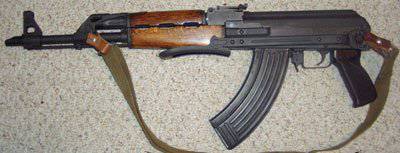 Thus, it can be said that this was already the second branch of evolution in 70 models. It was these samples that were modernized in the second circle and became those that were most prevalent in the army. They were given names for a long time without further thinking: М70В1 with a fixed butt and М70AB with a butt folding under the weapon. In addition to the obvious improvement in the form of new sights and reducing the cost of weapons through a stamped receiver, the weapon also received another very useful addition in the form of mounting optical and night sights, before that there was no possibility to install additional sights. In addition to the option of weapons for the army, on the basis of these machines, the civilian version of the weapon was developed, which differed only in the absence of the possibility of automatic fire, although in capable hands the machine became full-fledged again, but nobody needed it. The civil autoloading version was named Zastava M70 and earned quite good reviews from the owners.
Thus, it can be said that this was already the second branch of evolution in 70 models. It was these samples that were modernized in the second circle and became those that were most prevalent in the army. They were given names for a long time without further thinking: М70В1 with a fixed butt and М70AB with a butt folding under the weapon. In addition to the obvious improvement in the form of new sights and reducing the cost of weapons through a stamped receiver, the weapon also received another very useful addition in the form of mounting optical and night sights, before that there was no possibility to install additional sights. In addition to the option of weapons for the army, on the basis of these machines, the civilian version of the weapon was developed, which differed only in the absence of the possibility of automatic fire, although in capable hands the machine became full-fledged again, but nobody needed it. The civil autoloading version was named Zastava M70 and earned quite good reviews from the owners. Thus, the army of the Soviet Federal Republic of Yugoslavia received a reliable, simple and unpretentious version of an automatic rifle chambered for 7,62x39. Dimensions of the version of the weapon with a folding butt of the M70AB were 900 millimeters and 640 millimeters with the folded and unfolded butt, respectively, the barrel length was standard 415 millimeters. The weight of the weapon was equal to 3,75 kilogram. The machine was fed from detachable box stores with a capacity of 30 cartridges, had an automatic fire rate of 620 shots per minute, the effective range of the weapon was 500 meters, and the speed of a bullet at the muzzle was 720 meters per second. The version of the machine with a fixed butt differed only in greater weight, equal to 3,8 kilogram, length - 900 mm.
Thus, the army of the Soviet Federal Republic of Yugoslavia received a reliable, simple and unpretentious version of an automatic rifle chambered for 7,62x39. Dimensions of the version of the weapon with a folding butt of the M70AB were 900 millimeters and 640 millimeters with the folded and unfolded butt, respectively, the barrel length was standard 415 millimeters. The weight of the weapon was equal to 3,75 kilogram. The machine was fed from detachable box stores with a capacity of 30 cartridges, had an automatic fire rate of 620 shots per minute, the effective range of the weapon was 500 meters, and the speed of a bullet at the muzzle was 720 meters per second. The version of the machine with a fixed butt differed only in greater weight, equal to 3,8 kilogram, length - 900 mm.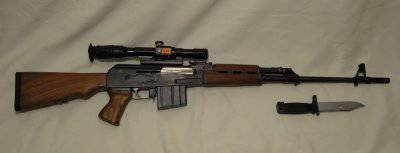 But you won't be fed up with one machine gun, the army needs another weapon, for example, a self-loading sniper rifle. Once Kalashnikov offered his version of a sniper rifle at the base of the machine gun, but the weapon did not pass in the Soviet Union, but Yugoslavia nevertheless decided to take a chance and launch a similar sample into the series, relying on the readiness of production to start production of this weapon, and not on characteristics sniper rifle. The new sniper rifle was designated the M76, and its operation was based on the principle of operation of automation on the extraction of powder gases from the barrel, and the barrel bore itself was locked when the bolt was turned to two lugs. Despite the fact that this weapon even externally is a Kalashnikov assault rifle, deprived of automatic firing, it was not possible to achieve full identity. The fact is that the M76 sniper rifle uses the 7,92x57 cartridge, and this led to the fact that the weapon, unlike the Kalashnikov assault rifle, had to make a longer box, respectively, its lid, as well as a tube for removing powder gases. In consequence of this, cheapness in the production of which was expected to be achieved was not, although the weapon still had an advantage in cost over samples that would have had to be produced "from scratch". The barrel of the rifle was 550 millimeters long, there was a right-side 4 rifle with millimeters 240 pitch in the barrel, a flame arrester was installed on the muzzle, which was very similar to the similar element of the SVD. The total length of the weapon was 1135 millimeters, the speed of the bullet at the muzzle was 720 meters per second, it is noteworthy that the weight of the rifle was only 3,97 kilogram, which is slightly more than the machine gun on the basis of which it was made. Meals were supplied from a detachable magazine with a capacity of 10 cartridges. The rifle has open sector sights that allow firing at distances up to 1000 meters. The truth here is to make a reservation that the "firing" and "fall" concepts are slightly different. In addition to them, on the left side of the weapon there is a dovetail mount for mounting optical sights. The standard sight for a weapon is the 4x multiple optical sight. Instead of a flame arrester, a silent shooting device can be installed, there is also a mount for a bayonet. The author of this weapon is Bozhidar Blagojevich, although many argue that this rifle was copied from a Kalashnikov rifle. We will not take a side in this matter, since everything is conditional, moreover, the M76 has been adopted and is still in use, but the Kalashnikov version of the sniper rifle can only be seen in the form of a prototype.
But you won't be fed up with one machine gun, the army needs another weapon, for example, a self-loading sniper rifle. Once Kalashnikov offered his version of a sniper rifle at the base of the machine gun, but the weapon did not pass in the Soviet Union, but Yugoslavia nevertheless decided to take a chance and launch a similar sample into the series, relying on the readiness of production to start production of this weapon, and not on characteristics sniper rifle. The new sniper rifle was designated the M76, and its operation was based on the principle of operation of automation on the extraction of powder gases from the barrel, and the barrel bore itself was locked when the bolt was turned to two lugs. Despite the fact that this weapon even externally is a Kalashnikov assault rifle, deprived of automatic firing, it was not possible to achieve full identity. The fact is that the M76 sniper rifle uses the 7,92x57 cartridge, and this led to the fact that the weapon, unlike the Kalashnikov assault rifle, had to make a longer box, respectively, its lid, as well as a tube for removing powder gases. In consequence of this, cheapness in the production of which was expected to be achieved was not, although the weapon still had an advantage in cost over samples that would have had to be produced "from scratch". The barrel of the rifle was 550 millimeters long, there was a right-side 4 rifle with millimeters 240 pitch in the barrel, a flame arrester was installed on the muzzle, which was very similar to the similar element of the SVD. The total length of the weapon was 1135 millimeters, the speed of the bullet at the muzzle was 720 meters per second, it is noteworthy that the weight of the rifle was only 3,97 kilogram, which is slightly more than the machine gun on the basis of which it was made. Meals were supplied from a detachable magazine with a capacity of 10 cartridges. The rifle has open sector sights that allow firing at distances up to 1000 meters. The truth here is to make a reservation that the "firing" and "fall" concepts are slightly different. In addition to them, on the left side of the weapon there is a dovetail mount for mounting optical sights. The standard sight for a weapon is the 4x multiple optical sight. Instead of a flame arrester, a silent shooting device can be installed, there is also a mount for a bayonet. The author of this weapon is Bozhidar Blagojevich, although many argue that this rifle was copied from a Kalashnikov rifle. We will not take a side in this matter, since everything is conditional, moreover, the M76 has been adopted and is still in use, but the Kalashnikov version of the sniper rifle can only be seen in the form of a prototype.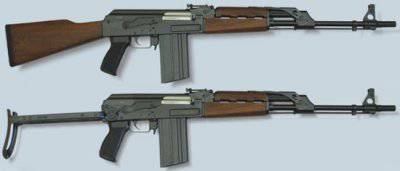 Thus, it was possible to obtain two samples for different purposes from the purchase of one license, but this is not yet the limit. In addition to weapons for his army, it was decided to supply weapons for export. New samples with the names М77В1 with a fixed butt and М77АВ1 with a folding butt for 7,62x51 cartridges received new direct stores with a capacity of 20 cartridges, respectively, new barrels, otherwise they remained the same Kalashnikovs. A rather interesting point was that the export versions had trunks of much higher quality than those produced for their own needs. Despite the fact that the weapon was quite good expectations, it did not meet. The ammunition turned out to be completely different from that with which it was possible to work comfortably in a weapon with such an automation scheme without its modernization, which was not produced naturally. As a result, the accuracy of fire was no when firing a burst, although in firing single shots, the results were good. In addition, these machines had a lower resource of work than the options under 7,62x39, which, of course, also affected the low popularity of weapons. However, it was possible to recoup their development and production of weapons, so they did not remain in the red.
Thus, it was possible to obtain two samples for different purposes from the purchase of one license, but this is not yet the limit. In addition to weapons for his army, it was decided to supply weapons for export. New samples with the names М77В1 with a fixed butt and М77АВ1 with a folding butt for 7,62x51 cartridges received new direct stores with a capacity of 20 cartridges, respectively, new barrels, otherwise they remained the same Kalashnikovs. A rather interesting point was that the export versions had trunks of much higher quality than those produced for their own needs. Despite the fact that the weapon was quite good expectations, it did not meet. The ammunition turned out to be completely different from that with which it was possible to work comfortably in a weapon with such an automation scheme without its modernization, which was not produced naturally. As a result, the accuracy of fire was no when firing a burst, although in firing single shots, the results were good. In addition, these machines had a lower resource of work than the options under 7,62x39, which, of course, also affected the low popularity of weapons. However, it was possible to recoup their development and production of weapons, so they did not remain in the red. Since we started talking about weapons for export, then we break the chronology and immediately analyze all the samples. It was reasonable to reason that the reason for not the highest success of export machines in the cartridge, it was decided to adapt the weapon for 5,56, so there were samples with the names M80 and M80А, with a fixed and folding butt, respectively. These automata differed from their progenitor with an elongated barrel, up to 460 millimeters, which made their maximum length equal to 985 millimeters, and for a sample with a folding butt the minimum length 725 was millimeters. In all other respects, they were completely analogous to the M70. This version of the weapon was “eaten up” with joy, although there remained complaints about the quality, which almost completely disappeared with the advent of the М90 and М90А models, which, thanks to the use of modern technologies and equipment, made it possible to achieve greater quality at minimal cost. The weight of the samples with a folding butt is equal to 3,55 kilogram, the weight of models with a fixed butt is equal to 3,6 kilogram. In addition, a compact version of the Yugoslav Kalashnikov assault rifle was also created for the 5,56 cartridge, which is an analogue of AKS74U. This sample was named M85, it has a folding butt. Its length with the butt spread out is equal to 760 millimeters, with folded 500 millimeters. The length of the barrel is 254 millimeter. Weight - 3,1 kilogram.
Since we started talking about weapons for export, then we break the chronology and immediately analyze all the samples. It was reasonable to reason that the reason for not the highest success of export machines in the cartridge, it was decided to adapt the weapon for 5,56, so there were samples with the names M80 and M80А, with a fixed and folding butt, respectively. These automata differed from their progenitor with an elongated barrel, up to 460 millimeters, which made their maximum length equal to 985 millimeters, and for a sample with a folding butt the minimum length 725 was millimeters. In all other respects, they were completely analogous to the M70. This version of the weapon was “eaten up” with joy, although there remained complaints about the quality, which almost completely disappeared with the advent of the М90 and М90А models, which, thanks to the use of modern technologies and equipment, made it possible to achieve greater quality at minimal cost. The weight of the samples with a folding butt is equal to 3,55 kilogram, the weight of models with a fixed butt is equal to 3,6 kilogram. In addition, a compact version of the Yugoslav Kalashnikov assault rifle was also created for the 5,56 cartridge, which is an analogue of AKS74U. This sample was named M85, it has a folding butt. Its length with the butt spread out is equal to 760 millimeters, with folded 500 millimeters. The length of the barrel is 254 millimeter. Weight - 3,1 kilogram.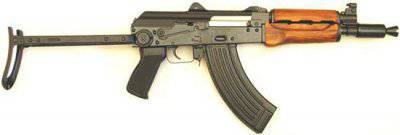 The compact version of the weapon was also created for 7,62x39 cartridges, already for internal use. This sample is powered by detachable magazines with a capacity of 30 cartridges, has a length with a butt of 800 of millimeters unfolded, with a folded 540 of millimeters. The length of the barrel of the weapon is 254 millimeter. Known sample under the name M92. The weight of the weapon is 3,1 kilogram.
The compact version of the weapon was also created for 7,62x39 cartridges, already for internal use. This sample is powered by detachable magazines with a capacity of 30 cartridges, has a length with a butt of 800 of millimeters unfolded, with a folded 540 of millimeters. The length of the barrel of the weapon is 254 millimeter. Known sample under the name M92. The weight of the weapon is 3,1 kilogram.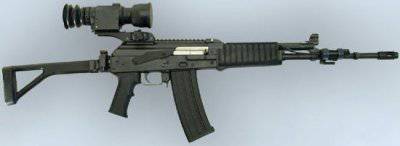 But that's not all. In 2004, the Serbian machine gun M21 appeared, which was also made in the image of the Kalashnikov assault rifle. At this time, the weapon has already been created on the basis of the cartridge 5,56х45, and this ammunition was chosen, most likely for political reasons. Machine M21, is a weapon, which tried to take into account the entire experience of previous developments. The machine is equipped with a folding butt, the option with a fixed butt does not exist, in the folded position the butt does not interfere with firing from a weapon. The open sights were changed, the opportunity to install additional sighting devices on a removable picatinny-type bar appeared. The pistol grip of the weapon was changed, the flame arrester was changed, the switch of fire modes was duplicated on the left side of the weapon in the form of a small lever convenient for switching with the thumb of the right hand without changing the grip of the weapon. On the right side of the machine, this control remained the same as the Kalashnikov machine gun. Plastic has found wide use in weapons, which in general has reduced the weight of the M21. Machine M21 has the ability to install 40-mm grenade launcher, in case of its use on the butt is put on a rubber "Shoe".
But that's not all. In 2004, the Serbian machine gun M21 appeared, which was also made in the image of the Kalashnikov assault rifle. At this time, the weapon has already been created on the basis of the cartridge 5,56х45, and this ammunition was chosen, most likely for political reasons. Machine M21, is a weapon, which tried to take into account the entire experience of previous developments. The machine is equipped with a folding butt, the option with a fixed butt does not exist, in the folded position the butt does not interfere with firing from a weapon. The open sights were changed, the opportunity to install additional sighting devices on a removable picatinny-type bar appeared. The pistol grip of the weapon was changed, the flame arrester was changed, the switch of fire modes was duplicated on the left side of the weapon in the form of a small lever convenient for switching with the thumb of the right hand without changing the grip of the weapon. On the right side of the machine, this control remained the same as the Kalashnikov machine gun. Plastic has found wide use in weapons, which in general has reduced the weight of the M21. Machine M21 has the ability to install 40-mm grenade launcher, in case of its use on the butt is put on a rubber "Shoe".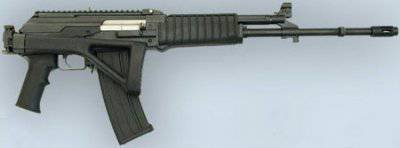 For internal use, the 3 version of the weapon is manufactured: М21 with a long barrel of 460 millimeters, М21S with a barrel length of 375 millimeters and M21C with a barrel length of 325 millimeters. Otherwise, this weapon is completely the same. Also available version M21SB for export. It differs from other models by a butt, a handle for carrying a weapon, as well as a fixed picatinny-type mounting strap. At the moment, М21 is in service with Serbia, Montenegro and Macedonia. Say what you like, but in this case, the designers did a great job, by following their own path of development they managed to make an alternative version of the Kalashnikov assault rifle. And let it “not ours”, but even glancing at him you can easily recognize the progenitor, who is known throughout the world.
For internal use, the 3 version of the weapon is manufactured: М21 with a long barrel of 460 millimeters, М21S with a barrel length of 375 millimeters and M21C with a barrel length of 325 millimeters. Otherwise, this weapon is completely the same. Also available version M21SB for export. It differs from other models by a butt, a handle for carrying a weapon, as well as a fixed picatinny-type mounting strap. At the moment, М21 is in service with Serbia, Montenegro and Macedonia. Say what you like, but in this case, the designers did a great job, by following their own path of development they managed to make an alternative version of the Kalashnikov assault rifle. And let it “not ours”, but even glancing at him you can easily recognize the progenitor, who is known throughout the world.These are the variants of the Kalashnikov assault rifle, first created in Yugoslavia, and then Serbia. Before embarking on commenting on the article, I would like the idea that the weapon does not influence the policy, but on the contrary it is quite possible. I would also like to see whether the continuation of a series of articles about relatives of Kalashnikov assault rifles is necessary, maybe something is missing in the articles or something superfluous. And this article, so to say "pilot series", so do not hit hard.
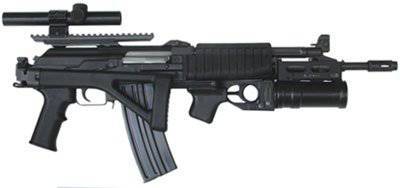
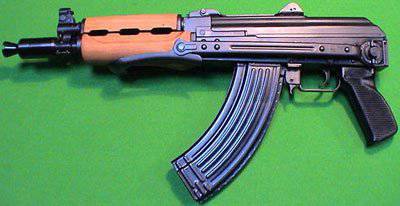
- Karasik Kirill
- weaponland.ru

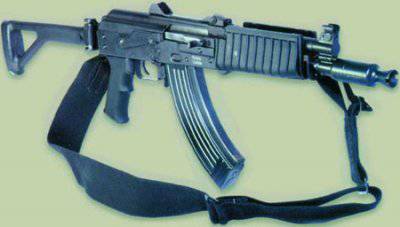

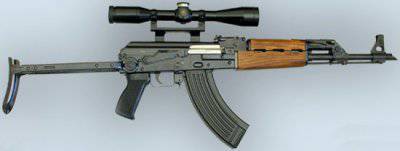

Information